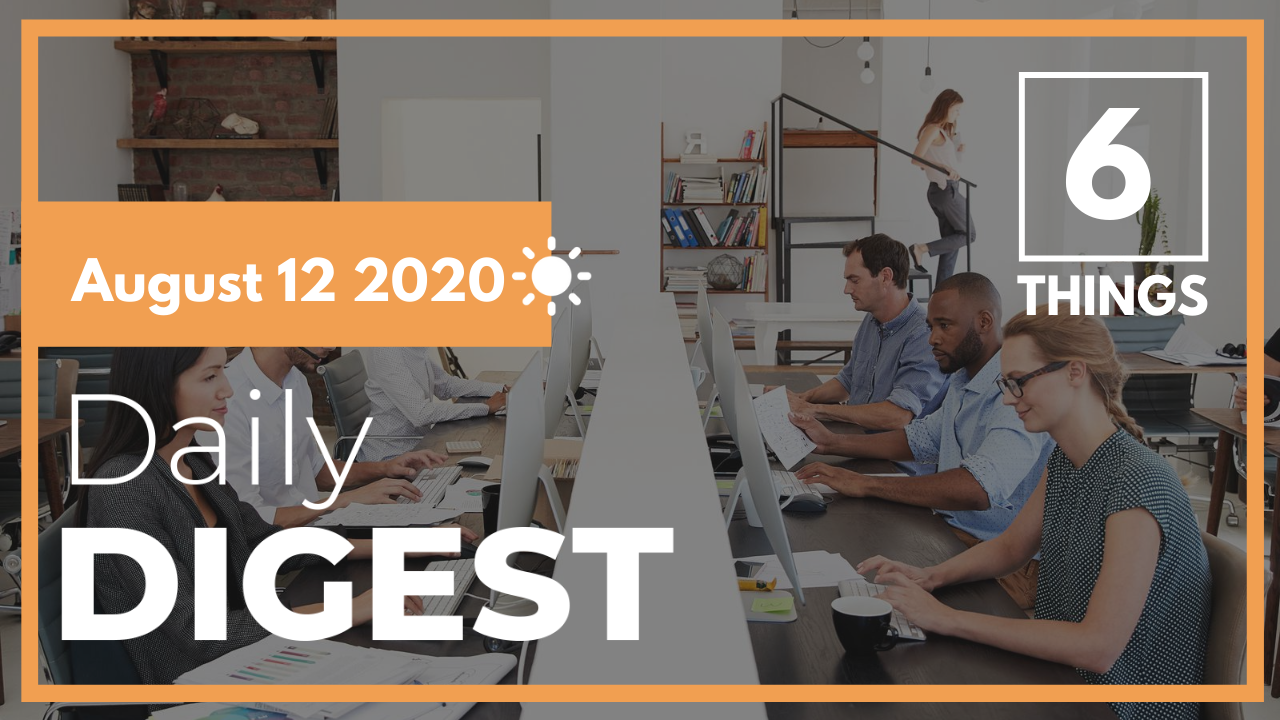Hand selected flexible workspace news from the most reliable sources to keep you ahead of the pack. We find all the latest news, so you don’t have to. Morning and afternoon updates. Stay in the know.
Here’s what you need to know today:
- The Real Estate Sector Will Bounce Back Next Year NEW
- Working Near Home Could Be The Future NEW
- Digital Nomads Are Growing In The Midst Of COVID-19 NEW
- Virtual Workplaces Offer A Place Of Connection
- Lessons From The Pandemic Can Improve The Workplace
- How To Achieve A Healthy Remote Work Routine
The Real Estate Sector Will Bounce Back Next Year
CBRE’s 2021 U.S. Real Estate Market Outlook predicts that offices, retail stores and hotels will begin to recover next year, particularly with news of the Pfizer vaccine looking promising.
The outlook indicates that interest rates will stay low, even with the GDP growing by 4.5% next year. However, the office industry may take longer to bounce back.
“Overall, we expect the real estate recovery, particularly the office sector, to lag the broader economic recovery by several quarters. This follows the pattern of previous cycles but with the added complication of getting people back into the workplace,” said Richard Barkham, CBRE global chief economist and head of Americas research, in the release. “Two factors are essential for this recovery to take hold: a medical resolution to COVID-19 through a vaccine and other measures, and another fiscal stimulus package.”
CBRE expects around 250 million square feet of industrial and logistics space to be absorbed next year, which is more than the prior five-year annual average of 211 million. Additionally, retail space will become more flexible in its usage.
Completed construction will also grow by 29% in 2021, while rents also continue to increase. In the meantime, the office market will begin to recover late next year.

Working Near Home Could Be The Future
The pandemic has forced millions of people to work from home and highlighted that this arrangement does not work for everyone. This has led to the emergence of the “work near home” concept that allows people to still have access to an office, while avoiding public transit into dense cities.
Companies typically use coworking spaces to serve as satellite offices in the suburbs, allowing employees to still cut down on stressful, daily commutes.
Adopting these offices allows companies and workers to cut down on expenses and be more flexible, since coworking spaces operate on short-term leases and are fully-outfitted with furniture.
Using these spaces may make it easier to accommodate all work styles or employees who simply do not have the resources they need to work at home. However, it is up to business leaders to make sure they are staying in the loop with other colleagues.
There are also issues of distancing when working in coworking spaces, which are known for their densely-packed environments. Still, it seems that many operators have adjusted their normal operations in order to meet new CDC recommendations, such as increased sanitation and keeping desks spaced out.
While it is still uncertain what the future of the workforce holds, companies can still do their part to make sure employees from all backgrounds are accommodated.

Digital Nomads Are Growing In The Midst Of COVID-19
Although digital nomads have had to mostly stay put since the beginning of the pandemic, more opportunities to be part of this community of traveling professionals is growing.
According to a survey from MBO Partners, digital nomads grew from 7.3 million last year to 10.9 million this year, a 49% increase.
However, digital nomads still only account for 7% of the U.S. labor force. This number is expected to grow as more and more companies have adopted the resources and infrastructure to accommodate these workers.
Meanwhile, many people have expressed wanting to become digital nomads over the next two or three years. Steve King, partner at Emergent Research, which helped conduct the survey, believes that these are “armchair digital nomads” who will never make the leap.
Digital nomads typically consist of entrepreneurs or those who are self-employed. According to the Freelance Forward survey commissioned by remote working platform Upwork, the amount of self-employed freelancers has grown. However, if full-time positions become more readily available in the next few years, this number could drop.
Regardless of how much the digital nomad population grows, it is evident that when offices open back up again, white-collar workers will still want to have the flexibility to work where they want.
“It’s going to mean that more of these people will say, ‘I can’t go to Barcelona or Thailand, but I can go to Boulder or Bend,’” said King.

Virtual Workplaces Offer A Place Of Connection
The office was once a place of spontaneity prior to the pandemic, with impromptu brainstorm sessions and post-work happy hours. Now, remote working has completely transformed how we think of the workplace, and the purpose it will serve in the coming years.
This has opened up a window of opportunity for a new type of office: a virtual one. Startups have scurried to create the best virtual offices for distributed teams, including Branch, Gather and Huddle.
All of these platforms are working to build a world that taps into multiplayer gaming culture, while providing the productivity tools and resources needed to keep the workplace engaged.
Branch is a startup that hopes to find a balance between work and play.
Branch’s virtual HQ features the traditional areas you’d see at your office: meeting rooms, lunch tables, a watercooler and even succulents on desks.
Then there’s Gather, which is one of the largest virtual HQ platforms at the moment. It has features such as “shoulder taps” to chat with coworkers, and even pool tables for employees to unwind during the day.
“You don’t need to worry about constantly worrying about if you’re being seen or not, but you will hear anyone who tries to come and talk to you,” said Phillip Wang, the founder of Gather.
Wang and his friends have been working to build Gather for around 18 months, even trying apps and VR to see which friends were available to chat. When the pandemic hit, the chance to tape into the workplace market became evident.

Lessons From The Pandemic Can Improve The Workplace
Although much of the world is experiencing a second or even third wave of the coronavirus, news of a vaccine has made it easier to see the light at the end of the tunnel.
The entirety of this year has been one of uncertainty and social unrest. To say there have been countless lessons to take away from 2020 would be an understatement, particularly how the workplace impacts us as humans.
One of the biggest takeaways of this year has been the understanding just how much humans are capable of, and what our limits are. This time has provided everyone better insight into how people function differently, as well as their ability to adapt and transform when necessary.
Additionally, the importance of top-down leadership has been brought to the forefront. Now, CEOs and business leaders have realized how essential it is to be transparent and offer a human-centric approach.
Leaders have also been challenged with the new task of keeping their employees engaged as they isolate from home. This includes taking into account the various experiences each person is having during these unprecedented times, and guiding with empathy.
Companies have also come to realize the importance of nurturing an ecosystem of partners to address all issues that can occur in the workplace. This can include Chief Medical Officers, CHROs, and other various partners to create a truly connected workforce.

How To Achieve A Healthy Remote Work Routine
Four out of five respondents from a Telus International survey revealed it was challenging to shut down at the end of the work day when working from home.
The survey also found that over half of respondents have not taken a mental health day since the beginning of the pandemic, despite a staggering 97% saying that vacation days are vital to working from home.
So what can business leaders do to ensure that employees are able to achieve a healthier work-life balance while they continue to operate remotely?
Michael Weening, COO of software provider Calix, says encouraging workers to take time off is essential to preventing burnout.
“You cannot recharge if you are constantly checking in,” said Weening. “That’s a rule I personally follow. Everyone takes their cues from leadership, so you have to lead by example.”
Adopting asynchronicity is also important, particularly if your workforce stretches across several time zones. Keeping a 9 to 5 schedule is antiquated at this point, and giving your employees the flexibility of when they work allows them to be more productive.
Natalie Baumgartner, chief workforce scientist at Achievers, suggests implementing a ‘no meetings’ time frame. Doing so can allow employees to focus on work or personal-related tasks without the interruption of a meeting.
Lastly, encourage workers to prioritize exercise throughout the day. Getting in extra steps each day can do wonders to improve mental health, as well as cognition and memory.



 Dr. Gleb Tsipursky – The Office Whisperer
Dr. Gleb Tsipursky – The Office Whisperer Nirit Cohen – WorkFutures
Nirit Cohen – WorkFutures Angela Howard – Culture Expert
Angela Howard – Culture Expert Drew Jones – Design & Innovation
Drew Jones – Design & Innovation Jonathan Price – CRE & Flex Expert
Jonathan Price – CRE & Flex Expert














